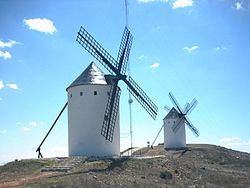My immigrant ancestor, Nicanor Gonzalo Sanchez-Tereso was born on 10 January 1791 in Herencia, Spain. He married Anna Marie Weber in 1815 in Bad Kreuznach, Germany. They had at least 7 children in between 1819 and 1833 while living in Germany. They immigrated to the US after the revolution and ended up settling in Keokuk county, IA. Sadly, they both died a couple of years after arriving.
I decided that I wanted to learn a bit more about the town of Herencia, where the Sanchez-Tereso family lived for at least a couple of hundred years. Nicanor’s ancestor, Juan Sanchez Tereso, was born there in 1620. (Related families that also lived in this area were: Gomez-Lobo, Lopez-Naranjo, Fernandez-Canadas, Martinez-Ojeda, Rodriguez-Polanco, Martinez-Oxeda, Garcia-Navas, Rodriguez Del Tembleque, Diaz De Ubeda, Martinez-Viveros and many more hyphenated names!)
Herencia is in the Province of Ciudad Real in the autonomous community of Castile-La Mancha, about 150 km south of Madrid. It has about 9,000 inhabitants. Fairly small.
I found a couple of websites for Herencia: www.herencia.net and www.herencia.es. The first seems to have more local news/events. The second had information on history, a map of the town, and pictures.
I had to use Google Translate to figure out what the sites said. I have taken Russian, German, and a little French, but Spanish is an absolute mystery to me. The words were translated so that I could get the gist of it, but it just sounded awkward. It’s much better than pulling out a dictionary though, isn’t it? I won’t complain. 🙂
What I could pick up from the translation was this: (Here is the direct link to the site. They have old pictures, which are neat to look at, even if you don’t speak Spanish)
- Herencia is translated as “Heritage” or “Legacy” (according to Google Translate). Now, isn’t that a cool name for a town?
- In 1239, after the Battle of Los Navas de Tolosa, the Kingdom of Castile began the repopulation of the Southern Plateau. The town of Herencia is given its charter. It has about 150 residents at this time.
- In 1568, a granary was built.
- They had vineyards and produced a lot of wine.
- In 1604, there is a population crisis because of poor harvests and typhoid epidemics.
- In 1786 there was an epidemic of malaria. Life expectancy at this time period was about 50.
- In 1790, the first of the windmills was built. By the early 1800’s, there were 11 windmills in/around Herencia.
- I love this translation: “In 1,798, the master of the alphabet, D. Alfonso García Rosel, teaches 90 children of all ages, including 12 of the poorest, who do not receive any money.” I wonder if my Nicanor (who was born in 1791) may have been one of these children.
- In 1808, they record that there are only 3 remaining windmills. It says that this may be due to the destruction by French troops during the War for Independence.
I also found a site that has an album of pictures from the area. Lots of windmills, reminiscent of Don Quixote. 🙂 Actually, the setting of Don Quixote is in this vicinity. It was neat to see what the area looks like. I would love to visit someday!!

Here is a translation of what the Herencia.es site had to say about the relation of Don Quixote to the area:
If the heirs of Cervantes had to collect intellectual property rights for the use of the names mentioned in Don Quixote, his would be one of the largest fortunes. In Legacy there is no corner that does not contain any reference to Cervantes’s fiction, from the stamp of their handmade cheeses, until the inevitable street and Plaza Cervantes. The very name of the people is in itself a valuable legacy.It is best to walk to the Plaza of Spain, where is the Church of the Immaculate Conception, then visit the Church of Our Lady of Mercy and walk the streets, that have a certain symmetry, with white as dominant color of the cityscape.. At the time of rest and food it is essential the presence of cheese Inheritance of universal popularity. Surely there will be no better place to buy a manchego cheese and taste
The most exciting thing that I found is a bit of information on the church where my ancestors attended: the Church of the Immaculate Conception. The church that is currently standing was built in the 18th century, which means that it is the same one that Nicanor and his family attended.
I have added visiting this place as number 153 on my life list. 🙂
Other questions I have about this area are: How was it affected by the Napoleonic Wars? This is the time period that Nicanor (later known as Nicholas) was living there. He would have been 16 when the Peninsular War started and 23 when it ended. Was he a soldier? Would he have gone to Germany as a soldier? Did he move there after the war, looking for a new life? He married in 1815 in Germany, after the wars ended.
I really know very little about this time period/place. I think that I only briefly studied it in high school and obviously didn’t retain anything. Everything I know about the Napoleonic Era was learned from watching BBC movies and reading Jane Austen novels. 🙂 Not a complete education, for sure.
Luckily, we will be studying Napoleon and the world in his time this January in our homeschool. Hopefully I will learn something too! I have a wonderful book entitled Historical Atlas of the Napoleonic Era. It has so many wonderful maps and paintings in it. I highly recommend it if you are looking for a book on this time period. I’m obviously not an expert though.
I looked at the map of Spain in the chapter titled “The Spanish Ulcer”, and there was definitely chaos all around where the Sanchez-Tereso’s were living. Even if they didn’t fight in the wars, they had to be affected by the things going on around them. Another thing I need to research is Nicanor’s siblings. Other than their birth and baptismal dates, I know absolutely nothing about them. Did they stay in Spain or did they move also?
I wonder if there are records of soldiers for this time period. Hmm. Things to think about. Any suggestions on where to look for further information? Does anyone know of any good books (in English) that give a good overview on daily life during this time period in Spain? Anyone want to speculate on why Nicanor moved to Germany?






